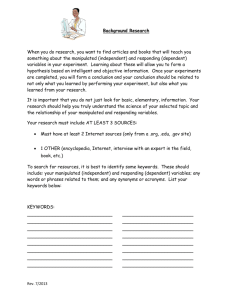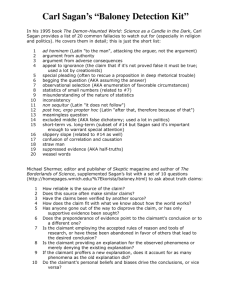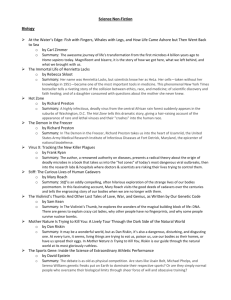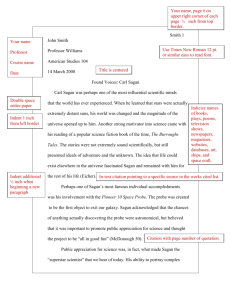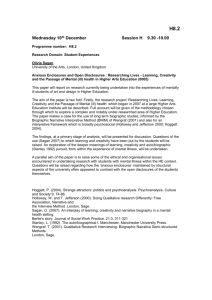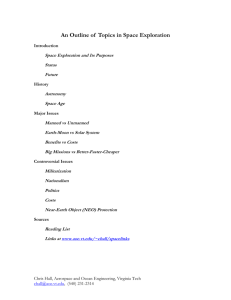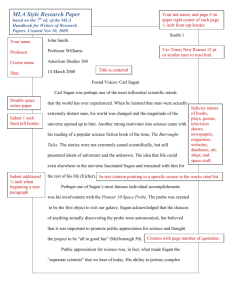Carl Sagan - National Academy of Sciences
advertisement
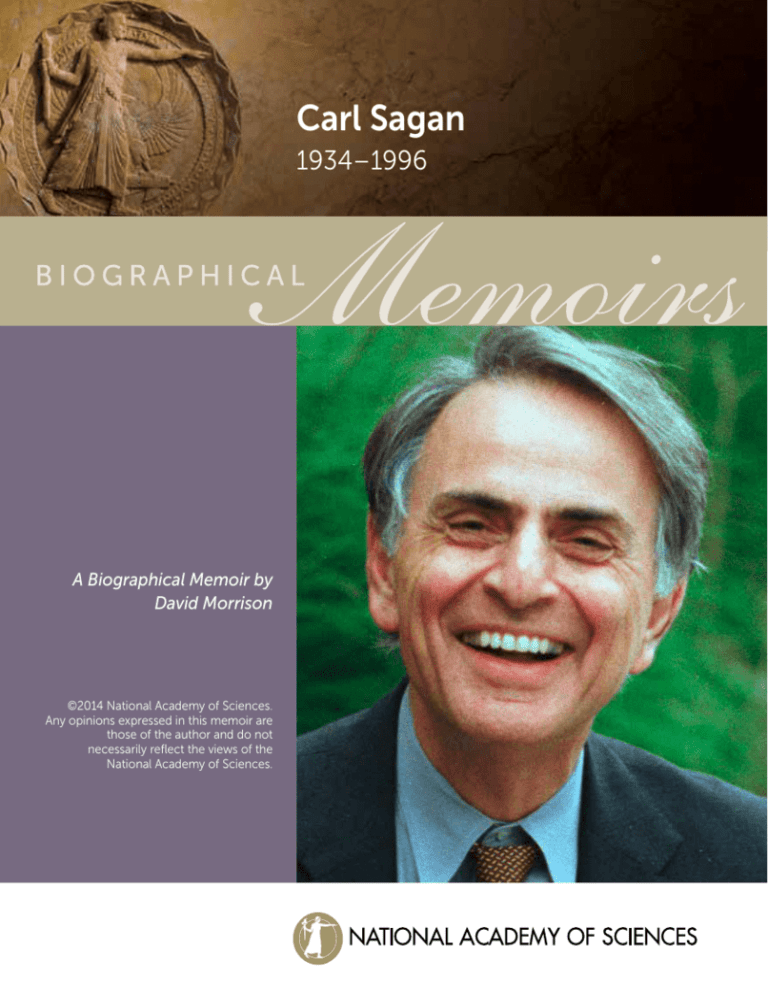
Carl Sagan 1934–1996 A Biographical Memoir by David Morrison ©2014 National Academy of Sciences. Any opinions expressed in this memoir are those of the author and do not necessarily reflect the views of the National Academy of Sciences. CARL SAGAN November 9, 1934–December 20, 1996 Carl Edward Sagan was a founder of the modern disciplines of planetary science and exobiology (which studies the potential habitability of extraterrestrial environments for living things), and he was a brilliant educator who was able to inspire public interest in science. A visionary and a committed defender of rational scientific thinking, he transcended the usual categories of academia to become one of the world’s best-known scientists and a true celebrity. By David Morrison Sagan was propelled in his careers by a wealth of talent, a large share of good luck, and an intensely focused drive to succeed. His lifelong quests were to understand our planetary system, to search for life beyond Earth, and to communicate the thrill of scientific discovery to others. As an advisor to the National Aeronautics and Space Administration (NASA) and a member of the science teams for the Mariner, Viking, Voyager, and Galileo missions, he was a major player in the scientific exploration of the solar system. He was also a highly popular teacher, but his influence reached far beyond the classroom through his vivid popular writing and his mastery of the medium of television. The early years orn in 1934, Sagan grew up in a workingclass Jewish neighborhood of Brooklyn, New York, and attended public schools there and in Rahway, New Jersey. His father (Samuel Sagan) immigrated to the United States from Ukraine as a boy, while his maternal grandparents came from the Austro-Hungarian Empire. His mother, Rachel Molly Gruber Sagan, was a great influence. She has been described as “vivacious, brilliant, paranoid, contradictory, flashy, completely loving, and fully devoted to Carl.” As a child, Carl read what science books he could find, but he especially enjoyed science fiction. B When he announced that he would like to become a scientist, his father advised him to first learn a profession so that he could support himself in his science “hobby.” A much 2 Photo Courtesy of NASA Awarded 1994 NAS Pubic Welfare Medal C A R L S AG A N wider intellectual world opened in 1951 when the University of Chicago provided Sagan with a full scholarship. There he involved himself in the broadly based “great books” program and also pursued his love of science. One of his biographers, Keay Davidson, observed that Sagan was inspired and troubled all his life by grand dichotomies—between reason and irrationalism, between wonder and skepticism.…He yearned to believe in marvelous things (UFOs, alien civilizations, life on Mars), yet reason usually brought him back to Earth (Davidson 1999). Sagan continued at Chicago for graduate work, receiving his doctorate in astronomy in 1960 with Gerard P. Kuiper as advisor. Kuiper wrote about his former student: “Some persons work best in specializing on a major program in the laboratory; others are best in liaison between sciences. Dr. Sagan belongs in the latter group.” Sagan’s thesis, involving a theoretical model of the atmosphere of Venus, demonstrated that the greenhouse effect of a thick atmosphere of carbon dioxide and water vapor could explain the newly discovered high surface temperature of that planet. During graduate school (in 1957) Carl married biologist Lynn Margulis, who had entered the University of Chicago at age 14. Margulis, who would become a leading evolutionary biologist and was elected to the National Academy of Sciences in 1983, later described their first meeting (when he was 20, she 16): “He was tall, handsome, exceedingly articulate…His gift of gab fascinated me …His love for science was contagious.” Their marriage lasted eight years and they had two sons, science writer Dorian Sagan and software developer Jeremy Sagan. Carl Sagan in 1969. (Photo by David Morrison.) Carl had a major interest in biology as well as astronomy. From childhood, he had been inspired by the mystery of the origin of life. This passion led him to collaborations with leading biologists such as Nobelists Stanley Miller, Joshua Lederberg, and George Muller. Early in his career, he received more encouragement from these biologists than from astronomers, many of whom considered planetary studies to lie on the fringes of respectable science, and exobiology to be beyond the pale. 3 C A R L S AG A N Feeling the need for a deeper understanding of biology, Sagan undertook postdoctoral work in biology at Stanford University and the University of California, Berkeley. Two of his first scientific papers focused on possible life in the solar system—on planets with reducing atmospheres (with Miller) and on Mars (with Lederberg). In 1961 Sagan published the book Intelligent Life in the Universe, the product of a long-distance collaboration with Russian physicist I. S. Shklovskii. This work had originally been conceived as a translation of Shklovskii’s book of the same title, but Sagan added new material, more than doubling the volume’s length. The contributions of the two As he often noted, only one authors were separated, taking the form of a dialog. generation was privileged to grow up when the solar system’s other planets and their moons were little more than dim points of light in the night sky and then to see them emerge as unique worlds with their own geological and perhaps even biological history. A campus star at Cornell In 1963, recently separated from Margulis (they divorced in 1965,) Sagan joined the Harvard University astronomy faculty as an assistant professor. At Harvard, he was a polarizing influence. Most of the students admired him, as did members of the public who attended his popular lectures “Planets are Places,” but many of the astronomy faculty demurred. His outgoing personality and interest in subjects outside the traditional astronomy curriculum set him apart. Told he would not receive tenure at Harvard, Sagan moved to Cornell University in 1968. That same year he married New York artist Linda Salzman. Their son Nick (Nicholas Julian Zapata) Sagan, born in 1970, became a novelist and screenwriter. At Cornell, Carl was appointed the David Duncan Professor of Astronomy and became director of the Laboratory for Planetary Studies. Both Cornell president Frank Rhodes and Tommy Gold, the new director of the Cornell Center for Radiophysics and Space Research, valued Sagan’s potential for what today would be called “out of the box” thinking, and he quickly became a campus star. On Sagan’s 60th birthday, Rhodes described him as a master teacher who also excelled in scholarship and service. He called Sagan “an inspiring example of the engaged global citizen—not remote, not isolated, but involved.…With the conscience of a humanist and the consummate skill of the scientist, he addresses the needs of society in which we live.” Sagan remained on the Cornell faculty to the end of his life. 4 C A R L S AG A N Sagan loved the research process, especially when it was combined with the exploration of new worlds. As he often noted, only one generation was privileged to grow up when the solar system’s other planets and their moons were little more than dim points of light in the night sky and then to see them emerge as unique worlds with their own geological and perhaps even biological history. He was an “idea person” and a master of intuitive physical arguments and “back of the envelope” calculations. He usually left the details to others, and most of his published papers were collaborations. Much of this work was done with students, many of whom went on to become leaders themselves in planetary science. In his early years at Cornell, Sagan played a major role in defining the two new interdisciplinary fields of planetary science and exobiology. He was selected as a member of the science teams for the Mars missions Mariner 4 and Mariner 9. For the 1976 Viking Mars mission he was one of three scientists (with Harold Masursky of the U.S. Geological Survey and The 1974 photo is of Carl with three of his former students: David Morrison, Joseph Veverka, Sagan, and James Pollack. Tobias Owen of Stony Brook (Photo by David Morrison.) University) who made the critical recommendations on where the two Viking landers should be targeted. He was a founding member of the Division for Planetary Science of the American Astronomical Society, and (with Isaac Asimov, Martin Gardner, and James Randi) of the Committee for the Scientific Investigation of Claims of the Paranormal (now called the Committee for Skeptical Inquiry). Throughout the 1970s and into the ’80s, Sagan edited what became the foremost professional journal in planetary science, Icarus. Popular communicator of science Sagan’s excitement with the process of scientific discovery is captured in the following passage, which he wrote in the early 1970s: “Even today, there are moments when what I do seems to me like an improbable, if unusually pleasant, dream: to be involved in the 5 C A R L S AG A N exploration of Venus, Mars, Jupiter, and Saturn; to try to duplicate the steps that led to the origin of life on an Earth very different from the one we know; to land instruments on Mars to search there for life; and perhaps to be engaged in a serious effort to communicate with other intelligent beings, if such there be, out there in the dark of the night sky.” Perhaps reflecting the freedom he felt at Cornell, Carl advocated for two unusual symposia, at annual meetings of the American Association for the Advancement of Science (AAAS), that involved direct confrontations between scientists and advocates of popular pseudoscientific beliefs. He believed that these symposia would demonstrate to journalists and the public how science works and that a civilized discussion of “fringe” topics was possible. At the 1969 AAAS meeting the topic was whether UFOs could be alien spacecraft. The two sides were reasonably well balanced, and Sagan (who as a boy had fervently hoped UFOs were real) made a low-key presentation that emphasized the absence of scientifically acceptable evidence for UFOs. In 1974, the AAAS subject was the popular pseudocosmology of Immanuel Velikovsky. The standingroom-only session devolved into a confrontation between contrasting personalities and intellectual styles: Velikovsky, looking like an Old-Testament patriarch, was a product of nineteenth-century European scholarly traditions. Sagan—young, witty, sarcastic—easily showed that Velikovsky’s catastrophism was incompatible with science. The press loved it, but Velikovsky left with an abiding hatred for Sagan and refused to allow his paper to be published in the symposium volume. Another activity that generated public interest was Sagan’s sponsorship of messages to be included in the four NASA spacecraft that were the first to leave the solar system entirely: Pioneers 10 and 11 and Voyagers 1 and 2. His wife Linda drew the iconic plaque on the Pioneers that represented a coded greeting from humans to any alien species that might eventually encounter the derelict spacecraft. For Voyager, Sagan led a team that designed a record for the Voyagers that included photos and sounds of Earth, as described in detail in his 1978 book Murmurs of Earth, whose coauthors included both his then-current wife Linda and future wife Ann Druyan. Sagan’s first major trade book, Cosmic Connection: An Extraterrestrial Perspective (1973), allowed him to share his scientific fascination with a much wider audience. In a review published in Science, William Hartmann described the book as feeling like a collection of dinner conversations with Sagan. This was no coincidence: he “wrote”—actually, dictated—the book’s first draft on a weeklong cross-country drive. Sagan developed his unique writing style by dictating all of his books and articles for transcription by his 6 C A R L S AG A N secretary. The result was content that, although often heavily edited by the author, read like conversations; conversely, his talks had the organization we associate with the written word. And Sagan got double (sometimes triple) duty from his creative work, with the same material appearing in talks, in magazine articles, and as chapters in his books. Sagan’s next book, The Dragons of Eden: Speculations on the Evolution of Human Intelligence, received the Pulitzer Prize for nonfiction in 1977, at about the same time he began regular TV appearances on the Tonight Show Starring Johnny Carson. That same year, Newsweek put Sagan on its cover. He was, the accompanying article said, “the leading spokesman and salesman for the new science of exobiology, the search for extraterrestrial life. Lobbying in Washington, appearing on television talk shows, and teaching at Cornell, he is building fresh support for the space program and fulfilling his own fantasies of finding life out there.” In 1980 he appeared on the cover of Time, shown wading in the “cosmic ocean.” Time described him as the “showman of science” and the “prince of popularizers.” In the public eye, Sagan’s name also became associated with the phrase “billions and billions.” He claimed that he never actually said this, that it was just part of a parody of his speaking style by Johnny Carson. At a public lecture I organized in Palo Alto, I watched a questioner from the audience pose and repose his question to try to force Sagan to answer The 1975 photo is of Carl with Hans Mark, Director of NASA with this phrase. After Ames Research Center, at the dedication of the Kuiper Airborne sparring a bit, Carl held Observatory. (Photo by David Morrison.) up a finger, grinned, and said, “I know what you want me to say, but I am not going to do it.” Only in his 1997 book Billions and Billions did he posthumously use this iconic phrase. 7 C A R L S AG A N Sagan moved to Los Angeles in 1978 to participate in the Voyager encounters with Jupiter and Saturn and to begin production of a 13-hour television series for the Public Broadcasting System called Cosmos. More than 400 million people saw Cosmos in dozens of countries around the world, making his name and face instantly recognizable. (Given his fame, my association with Sagan actually saved me from a speeding ticket in Texas; when the state trooper learned that I had been Sagan’s student, he tore up the ticket and launched into an enthusiastic discussion of Cosmos.) The accompanying book, also called Cosmos, was on the New York Times bestseller list for 70 weeks and made Sagan wealthy as well as famous. A champion of diverse issues In the 1980s, Sagan, probably the best-known scientist in the world at that time, continued to participate in the Voyager and Galileo planetary missions and to teach at Cornell. In 1980 he married the love of his life, Ann Druyan, after enduring an acrimonious public divorce battle with Linda Salzman. Carl and Ann moved into a fabulous house in Ithaca modeled on an Egyptian temple. They had two children, Alexandra Rachel (Sasha) Sagan and Samuel Democritus Sagan. With Bruce Murray of Caltech, he founded the Planetary Society, a public-membership organization to support planetary exploration. Partly inspired by Ann, Carl became more interested in philosophy and concerned about international politics and the threat of nuclear war. His energy was increasingly devoted to public education and the struggle against irrationality and pseudoscience, with less time to spend on his own research and on university teaching. Sagan was an outspoken critic of the nuclear arms race and of the “Star Wars” missile defense system proposed by the Reagan administration. This position led to frequent clashes with physicist Edward Teller, including a memorable debate before Congressional members and staff. An advocate for international collaboration in the pursuit of science, Sagan worked with Roald Sagdeev, the director of the Soviet Space Research Institute in Moscow, to promote a joint U.S.-Soviet manned mission to Mars—an enterprise that he believed had the potential to defuse the arms race and at the same time realize his dream of exploration of the planet most likely to harbor life. But the collapse of the USSR terminated this dream, and at home NASA’s robotic exploration missions were cut back after the 1986 explosion of the space shuttle Challenger. Meanwhile, Sagan’s vigorous public disputes over the likelihood of a “nuclear winter”—a term he coined for the global atmospheric obscuration by soot that would follow a fullscale nuclear-weapons exchange between the United States and the Soviet Union—may 8 C A R L S AG A N have contributed to the end of the Cold War (as he believed) but it also made him many enemies. By the end of the 1980s, Sagan had become a controversial political figure as well as a popular spokesperson for science. Carl in 1981, clowning with other Voyager scientists. Left to right are James Pollack, Steven Soter, David Morrison, and Gene Shoemaker. (Photo courtesy JPL.) The conflicting demands he made on himself are illustrated by an anecdote from a meeting of the Galileo mission imaging team, held just once a year during the long wait for a rocket to launch the spacecraft on its way to Jupiter. Carl participated enthusiastically at the meeting, and everyone was happy to see him involved again in the mission. However, when at the end of the meeting each team member was asked to describe his plans for the next year, Carl replied that while he had really enjoyed the meeting, he did not expect to be able to work on Galileo any longer because all of his time was committed to “saving the world from nuclear war.” His teammates conceded that this was indeed a worthwhile objective. Parade Magazine, the largest-circulation periodical in the United States, provided a venue by which Sagan could offer his knowledge and beliefs to an enormous reading audience. For Parade he wrote about science and planetary exploration, but he also provided essays on a variety of liberal causes, including feminism, animal rights, abortion, and the risks of militarization. Many of these essays, first written for Parade, were collected in his books Pale Blue Dot: A Vision of the Human Future in Space (1994) and Billions and Billions: Thoughts on Life and Death at the Brink of the Millennium (1997). 9 C A R L S AG A N Sagan was particularly concerned about the rise in anti-science and anti-intellectual attitudes. One of his finest books, published in 1995, was The Demon-Haunted World: Science as a Candle in the Dark. In it he noted that “pseudo-science is embraced in exact proportion as real science is misunderstood, [but although] science is far from a perfect instrument of knowledge, it is the best we have.” He also wrote there that finding the occasional straw of truth awash in a great ocean of confusion and bamboozle requires vigilance, dedication, and courage. But if we don’t practice these tough habits of thought…we risk becoming a nation of suckers, up for grabs by the next charlatan who saunters along. Although not an active participant in radio searches, Sagan was always a supporter of the search for extraterrestrial intelligence (SETI). He was one of 11 scientists at the 1961 meeting, at the National Radio Astronomy Observatory in Green Bank, West Virginia, where the “Drake Equation” (for estimating the number of detectable extraterrestrial civilizations in the Milky Way galaxy) was formulated. A successful SETI search was the basis for Sagan’s best-selling novel, Contact (1985), which was made into a successful 1997 film starring Jodie Foster. Carl in 1994, with Frank Drake, his In the early 1990s Sagan joined another long-time Cornell colleague and friend. debate at the interface of science and (Photo by David Morrison.) society, this one involving the hazard of asteroid impacts and how we might avoid them. While Sagan was an advocate for searching for potentially hazardous asteroids, he opposed proposals from the defense communities in the United States and Russia to develop and test nuclear weapons to destroy or deflect them. Both Sagan and Edward Teller attended a major asteroid-hazard meeting in Tucson in 1994, but they were unwilling to appear together on the platform. The conference organizers hoped for a joint communiqué signed by both Teller and Sagan, but Teller refused to even consider such collaboration. 10 C A R L S AG A N Sagan received many awards and honors, including the NASA Distinguished Public Service Medal (twice), the Peabody Award and two Emmys (for Cosmos), and the Pulitzer Prize (for The Dragons of Eden). The landing site of Mars Pathfinder was named the Carl Sagan Memorial Station, and the American Astronomical Society created the Sagan Medal, a lifetime-achievement award for communicating science to the public. However, in 1992 his nomination for membership in the National Academy of Sciences was unsuccessful. Two years later, the Academy awarded Sagan its prestigious Public Welfare Medal, which honored his popularization of science as well as his research. In 1996 Sagan died from complications of a rare blood disease called myelodysplasia, against which he had been struggling for the final two years of his life. At the time of his death he was deeply involved in seeing his novel Contact made into a Hollywood film, he had just joined the Board of Trustees of the SETI Institute, and he was working on joint publications with his last graduate student, Christopher Chyba. Among the most touching tributes he received were those from people who had never met him personally but who credited his influence in transforming their lives. Research contributions Sagan’s primarily scientific contributions spanned planetary science (especially studies of Venus and Mars) in addition to varied topics concerning life in the universe. He published more than 300 papers, an average of approximately 10 per year. Some highlights are summarized here, organized by topic. Venus’s atmosphere and clouds. Venus was considered Earth’s twin until its high microwave emissions were discovered in 1956, leading to a debate about whether they were originating on a hot surface or in the ionosphere. Neither of the two hypotheses was well developed, and many claimed that such a hot surface (nearly 700°K) was physically impossible. Sagan’s doctoral thesis developed a model that explained the high surface temperature of Venus as the consequence of an atmospheric greenhouse; he later coined the term “runaway greenhouse effect” to describe how a planet with initial conditions similar to those of Earth could evolve into such an extreme state. At this time there were still advocates for the ionospheric source of the microwave emission, but as an investigator on the first interplanetary spacecraft, Mariner 2, Sagan helped demonstrate that the high surface temperature was indeed real. 11 C A R L S AG A N In a long-term collaboration with James B. Pollack (of NASA’s Ames Research Center), Sagan developed models of increasing sophistication to explain the atmosphere of Venus and define the optical properties of gases and aerosols that could maintain the high surface temperature. These papers by Pollack and Sagan (1965–1976) are the definitive studies of such a large greenhouse effect. Sagan participated in vigorous debates about the nature of Venus’s clouds, which were once thought to be water but subsequently proved to be sulfuric acid. Mars dust storms and habitability. Before the investigation of Mars by spacecraft, the dominant paradigm was of surface conditions that, while harsh by terrestrial standards, still might support life. The idea of a habitable Mars had been among the romantic concepts that first drew Sagan into a scientific career. In the 1960s, the primary evidence for life on Mars was the “wave of darkening” that changed the albedo of parts of Mars in a roughly seasonal pattern. During the period 1966–1970, Sagan and Pollack developed the alternative hypothesis that the wave of darkening could be caused by wind-blown dust responding to seasonal wind patterns. They used the first measurements of the low atmospheric pressure on Mars and of apparently large elevation differences to develop realistic models of global atmospheric circulation. Ironically, while Sagan retained a strong interest in the search for life on Mars, his work critically undercut the idea of a wave of darkening as evidence of life. Instead, Sagan became an enthusiastic advocate for in-situ life-detection experiments on the Viking landers, which carried miniaturized instruments that were capable of finding trace quantities of microbial life in the soil—life that would be undetectable from Earth. The surveys of Mars by the Viking orbiters also provided definitive observational support for the wind-blown dust hypothesis and demonstrated how studies of wind streaks could be used to infer seasonal winds. With Pollack, Brian Toon, Peter Gierasch, and Richard Turco, Sagan investigated the feedback processes by which localized Martian dust storms could grow rapidly to global scales. The dust-transport and global-circulation models they developed for Mars were also applied to Earth—to better understand the high-altitude global spread of aerosols from volcanic eruptions and their possible climatic effects. The same models, when applied to stratospheric soot that might result from nuclear strikes targeted on cities and other domestic infrastructure, led to the concept of nuclear winter, as initially published in 1983. 12 C A R L S AG A N Organic chemistry of the outer solar system. Throughout his career, Sagan investigated topics involving the outer planets and their satellites, with an emphasis on organic chemistry. He established a laboratory program at Cornell to synthesize organic compounds under conditions (low temperature, reducing chemistry) that might be found in the outer solar system. With long-time collaborator Bishun Khare, Sagan synthesized a wide variety of amino acids using techniques that could be traced back to the Miller-Urey experiment. Sagan and Khare also produced a dark-red tar-like substance that matched the reflection spectrum from the clouds of Saturn’s moon Titan. Sagan named this material tholin (from the Greek word for “mud”). As astronomers provided more information on the spectra of the dark red material that is ubiquitous on the surfaces of outersolar-system objects such as comets and asteroids, his laboratory found organic tholins to match those spectra. Carl’s last two graduate students, Reid Thompson and Christopher Chyba, worked in areas related to organic materials on solar system bodies. Thompson was a lab chemist. Chyba focused on the delivery of organic materials to the early Earth, investigating under what circumstances these precursors to life could survive transport to the inner planets. 13 C A R L S AG A N REFERENCES Davidson, K. 1999. Carl Sagan: A Life. New York, NY: Wiley Morrison, D. 1999. Sagan and skepticism. Skeptic 7(4):29-32. Poundstone, W. 1999. Carl Sagan: A Life in the Cosmos. New York, NY: Henry Holt. Sagan, Carl. 1973. The Cosmic Connection: An Extraterrestrial Perspective. New York, NY: Doubleday. Terzian, Y., and E. Bilson (editors). 1997. Carl Sagan’s Universe. New York, NY: Cambridge University Press. 14 C A R L S AG A N SELECTED BIBLIOGRAPHY 1960 With S. L. Miller. Molecular synthesis in simulated reducing planetary atmospheres. Astron. J. 147:499. 1961 The planet Venus. Science 133:849-858. With I. S. Shklovskii: Intelligent Life in the Universe. San Francisco: Holden Day. 1962 Structure of the lower atmosphere of Venus. Icarus 1:151-169. With J. Lederberg. Microenvironments for life on Mars. Proc. Natl. Acad. Sci. U.S.A. 48:1473-1475. 1965 With J. B. Pollack. The microwave phase effect of Venus. Icarus 4:62-103. 1966 With E. R. Lippencott, R.V. Eck, and M. O. Dayhoff. Thermodynamic equilibria in planetary atmospheres. Astrophys. J. 147:753-764. With J. B. Pollack. Secular changes and dark-area regeneration on Mars. Icarus 6:434-439. 1968 With J. B. Pollack. Elevation differences on Mars. J. Geophysical Research 73:1373-1387. 1969 With J. B. Pollack. On the structure of the Venus atmosphere. Icarus 10:274-281. With J. B. Pollack. Windblown dust on Mars. Nature 223:791-794. 1970 With H. R. Hulett, A. Bar-Nun, N. Bar-Nun, and S. H. Bauer. Amino acid synthesis in simulated primitive environments. Science 170:1000-1002. 1972 Interstellar organic chemistry. Nature 238:77-80. With T. Page. UFOs: A Scientific Debate. Ithaca, NY: Cornell University Press. 1973 The greenhouse of Titan. Icarus 18: 649-656. With F. Drake. Interstellar radio communication and the frequency selection problem. Nature 245:247-248. With O. B. Toon and P. J. Gierasch. Climate change on Mars. Science 181:1045-1049. The Cosmic Connection: An Extraterrestrial Perspective. New York, NY: Doubleday. 15 C A R L S AG A N 1976 With J. B. Pollack and O. B. Toon. Volcanic explosions and climatic change: A theoretical assessment. J. Geophysical Research 81:1071-1083. With E. E. Salpeter. Particles, environments, and possible ecologies in the Jovian atmosphere. Astrophys. J. Supplement Series 32:737-755. 1977 Reducing greenhouses and the temperature history of Earth and Mars. Nature 269:224-226. The Dragons of Eden: Speculations on the Evolution of Human Intelligence. New York, NY: Random House. 1979 Broca’s Brain: Reflections on the Romance of Science. New York, NY: Random House. 1980 Cosmos. New York, NY: Random House 1983 With R. P. Turco, O. B. Toon, T. P. Ackerman, and J. B. Pollack. Nuclear winter: Global consequences of multiple explosions. Science 222:1283-1300. 1984 With B. N. Khare, E. T. Arakawa, F. Suits, T. A. Callcott, and M. W. Williams. Optical constants of organic tholins produced in a simulated Titanian atmosphere— From soft X-ray to microwave frequencies. Icarus 60:127-137. With W. R. Thompson. Production and condensation of organic gases in the atmosphere of Titan. Icarus 59:133-161. 1985 Contact (a novel). New York, NY: Simon & Schuster. With A. Druyan. Comet. New York, NY: Random House. 1986 With B. N. Khare, H. Ogino, B. Nagy, C. Er, K. H. Schram, and E. T. Arakawa. Amino acids derived from Titan tholins. Icarus 68:176-184. 1990 With C. F. Chyba, P. J. Thomas, and L. Brookshaw. Cometary delivery of organic molecules to the early Earth. Science 249:366-373. 1992 With A. Druyan. Shadows of Forgotten Ancestors: A Search For Who We Are. New York, NY: Random House. 16 C A R L S AG A N 1994 With S. J. Ostro. Dangers of asteroid deflection. Nature 368:501. Pale Blue Dot: A Vision of the Human Future in Space. New York, NY: Random House. 1996 The Demon-Haunted World: Science as a Candle in the Dark. New York, NY: Random House. 1997 Billions and Billions: Thoughts on Life and Death at the Brink of the Millennium. New York, NY: Random House. 1998 With S. J. Ostro. Cosmic collisions and galactic civilizations. Astronomy & Geophysics 39:22-24. Published since 1877, Biographical Memoirs are brief biographies of deceased National Academy of Sciences members, written by those who knew them or their work. These biographies provide personal and scholarly views of America’s most distinguished researchers and a biographical history of U.S. science. Biographical Memoirs are freely available online at www.nasonline.org/memoirs. 17

